← Return to Chapter 1: Before the Writing Bug Bit Me
(A reminder that I’ve included links throughout the text for more information on people, places, and things mentioned in case something piques your interest.)
When I think back to the first time I booted up my desktop PC in 1994 to a blank screen of word processing software, I wonder why I wasn’t intimidated by the idea of writing a book. I think some of my false confidence came from the knowledge that no one else had to know and I was free to fail in secret. I don’t believe I mentioned it to anyone at the time. I had no grand aspirations of writing something to be published—I just remember thinking it would be a fun exercise.
You might be surprised by the first story I began to write—it was a historical romance set in Kentucky during the Civil War. Kentucky was splintered by the war, with split loyalties to the Northern and Southern causes, pitting brother against brother in some cases. Additionally, many interests in Kentucky were neutral, including the Shakers, a pacifist religious sect with a large presence in central Kentucky called Pleasant Hill. (The contained village of Pleasant Hill still operates as a preserved tourist and educational attraction of the simple, peaceful Shaker life. If you find yourself in or around central Kentucky, it is a lovely family experience set in a pastoral landscape.) During the war, Pleasant Hill was a sanctuary for starving and wounded soldiers from both sides, and I thought it would be an ideal setting for a story of romance and personal conflict on an epic scale. In hindsight, it was an ambitious undertaking for a first novel, but I didn’t know any better.
At the time, I gravitated to writing historical romance because it was what I most loved to read. Pretty quickly, however, I found myself bogged down in research—I could get lost for hours reading books about the Civil War era and the location of one of the bloodiest battles in nearby Perryville. Weeks later, I had pages of notes for my story, but I hadn’t made much progress in page count. So I made a decision that would set the course for my future writing career—I decided to switch to contemporary romance. That said, I still wasn’t getting very far on my own.
I subscribed to Writers Digest magazine and began to dabble in other types of writing—articles and short stories. I spent my Saturdays at the public library pouring over the voluminous copy of Writers Market, searching for the names of magazines accepting unsolicited ideas and written pieces. I’ve always been interested in fabric and clothing construction, so I submitted ideas to a sewing magazine and managed to sell a couple of articles. The checks were tiny, but they felt like a victory.
It was around this time that I began to share with family and friends that I was writing in my spare time. I signed up for a local fiction writing class, but ack, it wasn’t a great experience. The instructor, although well-intended, I’m sure, employed a woo-woo style and encouraged everyone to sit in a circle and read our work aloud in low lighting. (People who know me well are belly-laughing right now.) She wasn’t impressed with my stories about romance and intrigue that had a happy ending—she insisted that writing was about exploring philosophical ideals and delving into past trauma. It was my first revelation about the profound differences between literary and genre writing and helped me to realize I didn’t want to write certain types of stories. The class made me more committed than ever to write genre fiction with no message or goal except to entertain!
About that same time, I saw a mention in the Lexington-Herald that Kentucky novelist Teresa Medeiros (a lovely woman I would later meet) would be speaking at the annual Romance Writers of America (RWA) conference. I was elated to learn an entire organization existed for romance writers! At the public library I found a phone number for RWA to get more information about joining. I learned there were state chapters within the national organization, and I was given a contact name and number for the group that met in Lexington. I was starting to have aspirations of actually selling a romance novel, and I couldn’t wait to attend the next meeting. Looking back, my expectations were a little too high and indicative of many aspiring novelists.
The meeting took place on a weekday evening at the food court of a local shopping mall. I soon realized the location was to accommodate the children of the dozen or so members, all of whom were women. There I was in my navy suit, fresh from my corporate job and hoping for a checklist of what I needed to do to get my book written and sold. Instead the meeting was a cross between a Mommy-and-me night out and romance fan club where members traded novels they liked. A couple of members stood and read scenes from stories they were writing, shouting to be heard above the incredible noise level. With apologies to those nice women who were doing the best they could with so many commitments, it was chaos. Understandable, though, because at that time, resources for writers were few and elusive. I was happy to meet other aspiring authors, but I was looking for a group that was a little less social and a little more focused. I didn’t think I’d be coming back. As I was leaving the meeting, two attendees pulled me aside—Annie Jones and Beth Harbison. (Annie and Beth have achieved great publishing success, click on their names to read more about them and their work.) They said I looked as if I was serious about getting published and so were they, so would I be interested in meeting on our own to exchange work?
I immediately said yes! After that, once a week, the three of us converged over Annie’s kitchen table to exchange pages of our stories and share bits of information we had gleaned from RWA publications and writing magazines. We split up the mailing addresses of publishers accepting romance manuscripts and sent off self-addressed stamped envelopes requesting “tip sheets” that described what they were and weren’t looking for. It would take weeks, if not months, to get back the heavily-photocopied tip sheets, so when one of us received a sheet, we would call each other excitedly and pour over them when we met for critique.
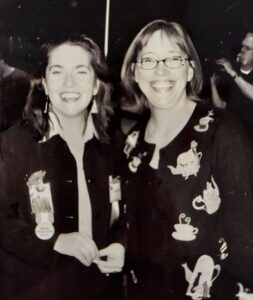
Me and Annie Jones, circa 1997
Early on, we targeted Harlequin Enterprises, the biggest publisher of romance, for our manuscripts. Harlequin had purchased competitor Silhouette Books, plus Mills & Boon, the iconic publisher of romances in the UK, Europe, and Australia (Barbara Cartland, anyone?). Harlequin released dozens of romance novels every month all over the planet in dozens of languages. The books were known as “category” romances meaning a certain type of romance was released under a “line”—Silhouette Romance and Harlequin Romance were shorter, sweeter romances, while the Harlequin Presents line featured international settings with more sweeping stories. Other lines featured romantic suspense, family drama, and historical storylines.
(If you’re interested in the history of romance novel publishing, check out the Harlequin About Us page and scroll down to Our History. Also, you might enjoy For Love and Money: The Literary Art of the Harlequin Mills & Boon Romance and A Natural History of the Romance Novel.)
The star of category romances is the “line” over the author—if a reader subscribed to a line, they received four or six books a month through the mail, and readers who purchased books in person would likely buy the entire line for that month. Writing for category romance was a boon to beginning writers because the audience for the line was already established. A new writer could reach untold numbers of readers and begin to build name recognition, so selling a manuscript to Harlequin was akin to hitting the career lottery—if not in terms of money, then in terms of exposure. I bought and read countless romance novels to narrow down the lines I wanted to target.
Every week Annie, Beth, and I exchanged pages of our manuscripts, giving feedback on what was working and what needed to be fixed. I learned so much by reading their pages and tried to apply what I’d learned to my own pages. I had stuck to my decision to write contemporary romance and because I enjoyed reading family dramas and watching them on TV, those were the kinds of stories I wrote. Although the stories had a happy ending, they were riddled with conflict and emotional ups and downs about serious family issues.
When we deemed our manuscripts were “ready,” we submitted them in cumbersome envelopes to faceless editors in Ontario and New York, along with the requisite self-addressed envelopes stamped with enough postage to return our manuscript in the (very) likely event the editor rejected it.
It would literally be months before we received a response to our submissions. We’d heard that good news always came in the form a phone call, and bad news came in the form of a returned manuscript. The best “bad” news one could hope for was a personal note as to why the manuscript had been rejected and occasionally, an invitation to resubmit once the problems had been addressed. I remember well opening my mailbox and hoping NOT to see a returned manuscript, but that’s what I received every time, and always with a form rejection letter, with no hint of why my manuscript had been rejected and no invitation to submit again. (Note: I’m away from my archives as I write this, but I think I kept some of my rejection letters and if so, will post them here at a later date.) After a rejection, the only recourse was to revise the manuscript to fit another line and resubmit it, or to start a new project. Annie, Beth, and I bonded over many rejections and despite the disappointment, I loved every minute of it because I was learning so much.
(Oh, how times have changed! Now the information my friends and I worked so hard to get our hands on is available at the click of a button. If you’re interested in writing for Harlequin, check out their Write for Harlequin page.)
During this time I was also enjoying my full-time job as a systems engineer. The department I worked in at Ashland Oil (now Marathon) was staffed with eager, talented IT professionals and in hindsight, it’s incredible the amount of work the group churned out collectively. Every day I felt as if my brain was firing on all cylinders. At one point my manager was out on maternity leave and the senior systems engineer I reported to had recently left. At the same time, a high-profile system I supported (Stockholder Records) was tasked with implementing a two-for-one stock split which, for obvious reasons, had to be undertaken in secret. I worked evenings and weekends, but still found time to write fiction an hour here and there. Writing was a break from my busy corporate job, although I still didn’t view it as a replacement vocation. My goal was to sell a book or maybe two as a hobby and for personal enrichment.
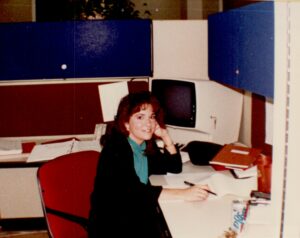
My first day working at Ashland Oil (now Marathon) in Lexington, Kentucky, May 1987.
Get a look at that huge computer terminal, and the 1980s primary colors in my 6’x6’ cubicle.
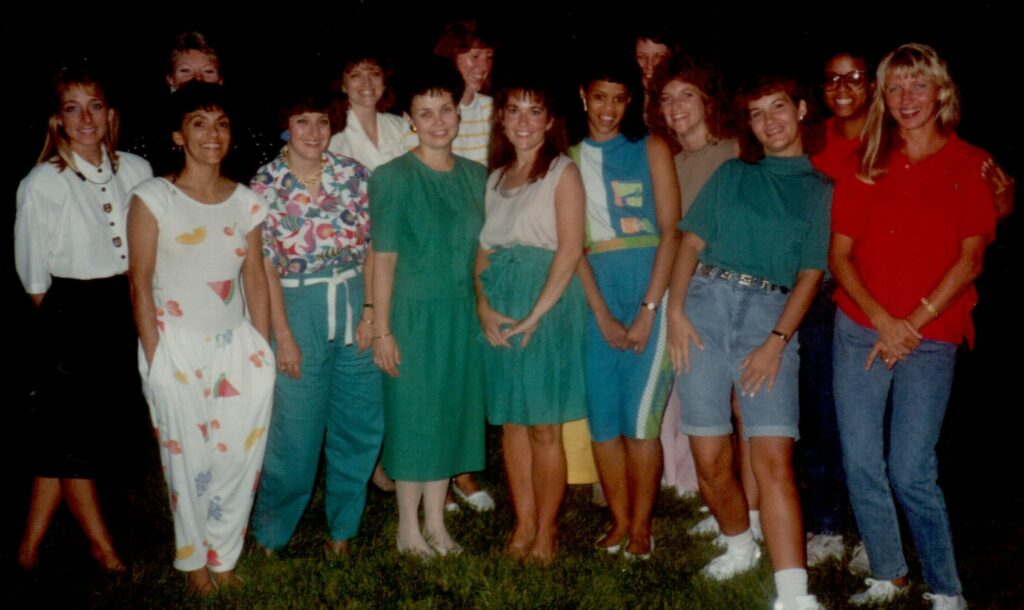
Some of my coworkers at Ashland Oil, Lexington, Kentucky, circa 1990.
These ladies were some of my biggest supporters when I finally published a book.
Then in 1995 my spouse was offered a promotion by his company to relocate to Atlanta. My company had a division in Atlanta, so I put in for a transfer. I also attended the national Romance Writers of America conference in NYC, which opened my eyes to the business side of the writing industry. While there, I found someone who belonged to the Georgia Romance Writers (GRW) group and made arrangements to join when I got there. Sadly, I said goodbye to my critique partners in Lexington, both of whom were now getting “good” rejection letters, and I moved to the suburbs of Atlanta.
The move to a bigger city was exciting, but early on, I realized the atmosphere in the division I’d transferred to wasn’t as upbeat or dynamic as the department I’d left. Conversely, the large GRW contingency was made up of accomplished novelists and (mostly) women who were determined to educate and uplift each other. Every monthly meeting was a heady mix of business bootcamp and pep rally. After the meetings we caravaned to a Waldenbooks (remember them?) to buy books written by members that had been released that month. I was in awe of the writers who’d published 10, 20, even 30 books! For the first time, I began to wonder if I could make a living writing romance novels and decided it was time to get serious about my writing. Meanwhile, I was cheering on my former critique partners in Kentucky who both had recently sold their first manuscripts to Harlequin and Silhouette.
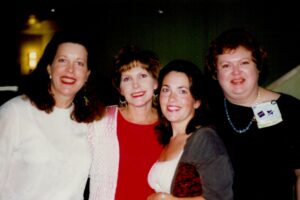
Members of Georgia Romance Writers, from L to R:
Lyn/Virginia Ellis and ½ of Raven Hart, Rita Herron, me, Susan Goggins/½ of Raven Hart
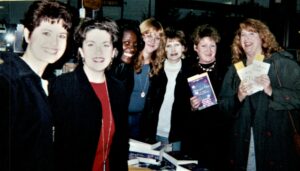
Members of Georgia Romance Writers, from L to R:
Jacquie D’Alessandro, me, Carmen Green, Jennifer St. Giles, Rita Herron, Jennifer LaBrecque, Anna Adams
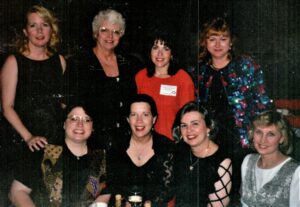
Georgia Romance Writers members, standing, L to R:
Patricia Van Wie, Sandra Chastain, me, Jennifer St. Giles
Seated, L to R: Debra Dixon, Lyn/Virginia Ellis and ½ of Raven Hart, Ann White, Donna Sterling
One Saturday in line at Waldenbooks I met Rita Herron who would become my longtime critique partner and closest writing friend. In Rita I found a kindred spirit who was as ambitious as I was. (Rita is SO prolific and successful, check out her website here.) We began to meet every week to exchange work and I was reinvigorated, bolstered by the events sponsored by GRW.
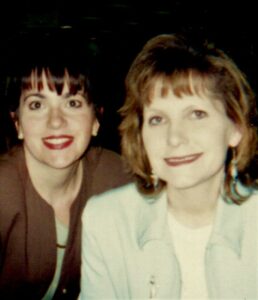
Me and longtime critique partner Rita Herron, circa 1996
One of the GRW events featured Harlequin editor Brenda Chin, who acquired for a family drama line I was targeting. She read aloud anonymous query letters that pitched an idea for a book, then she commented on which ones she would request and which ones she might pass on, and why. I’d submitted a query letter for a story I was writing, and I was excited when she read my letter aloud. At the end of it she said she’d be willing to read the manuscript, so the author could go ahead and submit it. Then she added that she’d like to talk to the person who’d written the letter, so would the author please find her afterward?
I was a nervous wreck but after the event I walked up and introduced myself. Brenda was surprisingly friendly and said she was actually acquiring for a brand-new romantic comedy line that hadn’t yet been announced, and she thought my query letter had a light and funny “voice.”
“Do you write romantic comedy?” she asked.
I had a decision to make. I didn’t write romantic comedy—no one had ever told me I was funny and in fact, most people would say I was the opposite of funny. I didn’t tell jokes and I didn’t always get the punch lines of other people’s jokes. But I also recognized the enormous opportunity of an editor standing in front of me asking if I wrote something she was looking to buy.
“As I matter of fact, I do write romantic comedy,” I lied.
She smiled, then asked me to tell her about a rom com I’d written.
My mind raced. I’d recently read a story about pheromones used in perfumes, so I opened my mouth and said I was writing a story about a woman who signs up for a clinical study on pheromones and becomes irresistible to every man she meets.
Brenda nodded. “I like it. How much of it’s written?”
I was sweating now, but in for a penny, in for a pound. “Oh, it’s one of those books that seems to be writing itself. I can send you a polished proposal in a week or so.”
She said great, she’d be looking for it, then gave me her card and went on her way.
Gulp! My heart is racing as I write about it even after all these years. I’d just promised to send an editor a synopsis and three chapters of a story I’d thought of on the spot and for which I didn’t have a single word written.
It was time to put up or shut up. ~
→ Go to Chapter 3: Writing and Selling my First Book